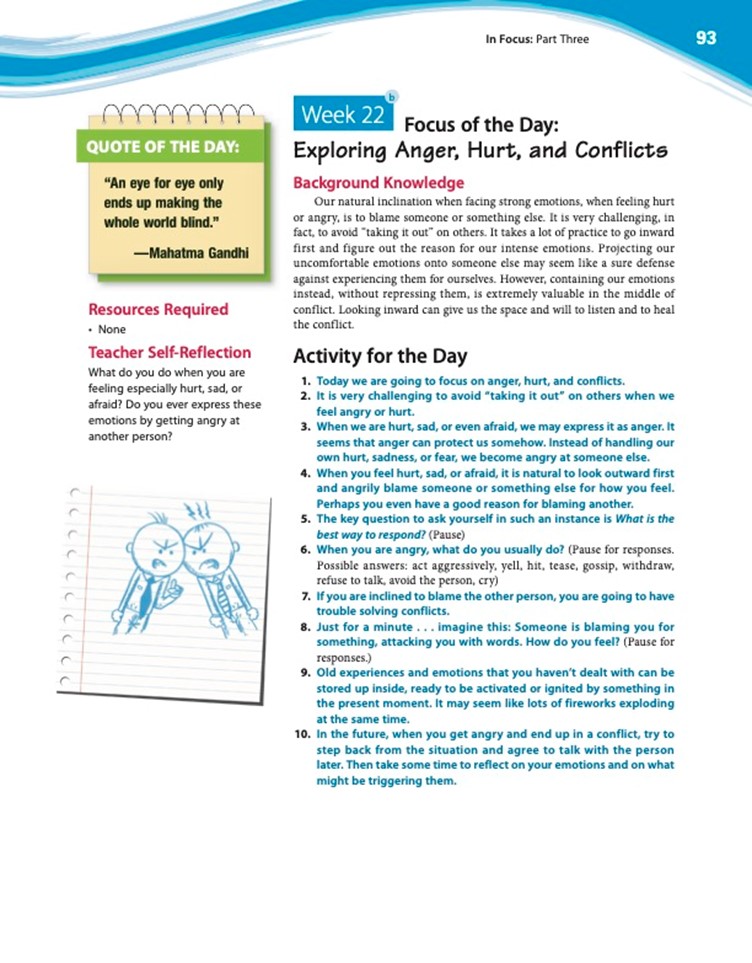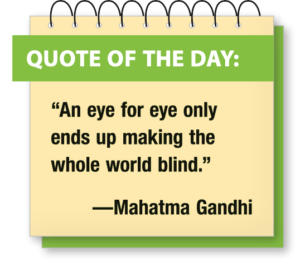Anger and hurt are linked emotions that are present in conflicts, and the inability of students to manage their anger and hurt can cause conflicts to escalate into violence.
Being unaware of our anger is actually dangerous. When we do not express it in positive, respectful ways on a regular basis, anger can build to a rage. It is clearly a powerful emotion that needs to be harnessed and used wisely. This is why it is important to teach students to recognize anger, to sense when it is building, and to express it responsibly. Ideally, students can learn how to direct the power of anger into positive activities, like speaking up or taking nonviolent action against an injustice.
If a student expresses anger, he or she is also feeling hurt beneath the anger. And depending on what is allowed at home, a student will express one emotion more than the other. For example, if expressing hurt causes a student to feel unsafe in the classroom, they will protect themselves by simply getting angry.
Students who are aware of their anger and can sense it physically are better able to manage this intense emotion than those who have not developed such an ability. Being aware of their rising anger offers them a chance to choose how they will respond to it. Remind your students that when they are in the middle of a conflict and feeling angry, stepping back from the situation and agreeing to talk later is a good idea.
Resisting or denying emotions creates pain and isolation, while honoring emotions and sharing them with other people in a responsible, grounded fashion connects us. Being attuned to and honoring your students’ emotions can greatly reduce the inappropriate display of intense emotion in your classroom and help students to deal effectively with conflicts so they do not intensify into violence.
Our brains have evolved over millions of years, and the limbic system, which generates our emotions, has developed to help us survive, informing our decisions. Society often judges emotions and their expression as a sign of weakness; but it is important to remember that all emotions are okay. What is sometimes not okay, however, is the way in which we express our emotions.
Let’s focus in this blog on teaching a lesson on anger management for middle school students. This lesson comes from my In Focus SEL curriculum that I created.
Here is a picture of an In Focus SEL lesson plan on anger management for middle schoolers. See below for the different parts to the lesson.


Exploring Anger, Hurt, and Conflicts
Background Knowledge
Our natural inclination when facing strong emotions, when feeling hurt or angry, is to blame someone or something else. It is very challenging, in fact, to avoid “taking it out” on others. It takes a lot of practice to go inward first and figure out the reason for our intense emotions. Projecting our uncomfortable emotions onto someone else may seem like a sure defense against experiencing them for ourselves. However, containing our emotions instead, without repressing them, is extremely valuable in the middle of conflict. Looking inward can give us the space and will to listen and to heal the conflict.
Activity for the Day
- Today we are going to focus on anger, hurt, and conflicts.
- It is very challenging to avoid “taking it out” on others when we feel angry or hurt.
- When we are hurt, sad, or even afraid, we may express it as anger. It seems that anger can protect us somehow. Instead of handling our own hurt, sadness, or fear, we become angry at someone else.
- When you feel hurt, sad, or afraid, it is natural to look outward first and angrily blame someone or something else for how you feel. Perhaps you even have a good reason for blaming another.
- The key question to ask yourself in such an instance is What is the best way to respond? (Pause)
- When you are angry, what do you usually do? (Pause for responses. Possible answers: act aggressively, yell, hit, tease, gossip, withdraw, refuse to talk, avoid the person, cry)
- If you are inclined to blame the other person, you are going to have trouble solving conflicts.
- Just for a minute . . . imagine this: Someone is blaming you for something, attacking you with words. How do you feel? (Pause for responses.)
- Old experiences and emotions that you haven’t dealt with can be stored up inside, ready to be activated or ignited by something in the present moment. It may seem like lots of fireworks exploding at the same time.
- In the future, when you get angry and end up in a conflict, try to step back from the situation and agree to talk with the person later. Then take some time to reflect on your emotions and on what might be triggering them.
Resources Required
- Large poster or piece of paper listing the six primary emotions (happiness, sadness, anger, hurt, fear, and love)
Teacher Self-Reflection
Are you able to express your anger (in a grounded, contained fashion) in front of your students? What are your beliefs about expressing anger in your classroom or in public?
If you would like more information about In Focus SEL curriculum, which includes a number of lesson plans for elementary and middle school students to handle their emotions, click the link below.
https://teachingheartinstitute.com/in-focus-sel-curriculum/
If you want to stay connected to my social emotional work with teachers, parents, and coaches, click the link below and let me know that you want to receive my Teaching Heart Institute newsletter.
https://teachingheartinstitute.com/contact-tom/
Tom McSheehy, MSW, LSW, taught elementary and middle school for 21 years and has been a licensed social worker for 26 years. Tom is the author of In Focus SEL curriculum and has been working in the area of social emotional learning (SEL) for 36 years.




